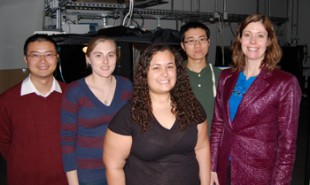Rice University technique could widen bottleneck for pharmaceutical, other industries
Rice University scientists have created a way to fine-tune a process critical to the pharmaceutical industry that could save a lot of time and money.
A combination of the Rice technique that provides pinpoint locations for single proteins and a theory that describes those proteins’ interactions with other molecules could widen a bottleneck in the manufacture of drugs by making the process of isolating proteins five times more efficient.
The work by Rice chemist Christy Landes and her team will be reported online this week in the Proceedings of the National Academy of Sciences .
A critical step in drug manufacture is the separation of “proteins of interest” – the active elements in drugs – from other materials. The primary method used is ion-exchange chromatography , which is like using a colander to separate cooked pasta from water. In this case, a separation column removes proteins from water and other cellular material. Landes said raw material containing the proteins is injected into the top of a separation column, or tube. The mixture is the “mobile phase” of the process, and it can either be pulled through the tube via gravity or pushed through.
Along the way, the liquid encounters a “stationary phase,” a structure that incorporates ligands – binding ions or molecules. In theory, they capture only the proteins of interest, while the unwanted material passes through. The proteins are later washed off in a purifying step called elution . It’s this stationary phase that Landes said should be tuned. That can only happen by knowing what occurs at the molecular level.
“Our fundamental understanding of this process at the level where proteins bind to ligands, which basically drives several different industries, is ridiculously small,” she said. “We should take care to understand everything about separation, because up to half the cost of bringing a drug to market is for separation and purification – and the global pharmaceutical market is more than $100 billion annually. Do the math!”
The remarkable part, Landes said, is that the stochastic theory of chromatography , which describes single-molecule interactions and could improve the process, has been around for decades. But until now, nobody has had access to a tool to validate it through experimentation, especially for single proteins.
“It can actually describe and let us tune at the chemical level what’s really going on in separations,” she said of the theory. “But the only way to use the theory is to collect the information that describes the interaction one protein at a time.”
Landes and her team, which included lead author and graduate student Lydia Kisley, postdoctoral researcher Jixin Chen, undergraduate Andrea Mansur and graduate student Bo Shuang, decided they had the way. They found that the super-resolution technique called mbPAINT they developed to identify individual sequences along strands of DNA could work equally well for other processes that involve the capture and release of single molecules, such as the proteins and ligands in chromatography.
The earlier work let them resolve structures as small as 30 nanometers – 30 billionths of a meter, at least 10 times smaller than the wavelength of light – by building up pictures over time of a probe molecule that would fluoresce when temporarily captured by the immobilized DNA.
The ability to map the location of proteins as they attach to ligands gives a much more precise look at the mechanism that makes column chromatography possible, Landes said. It also let the Rice team look at the process in a two-dimensional, rather than three-dimensional, format as they attached ligands to a film rather than a chromatography tube.
The results showed that at the molecular level, ligands embedded in the agarose -based stationary film would only capture proteins — in this case, a synthesized peptide — when at least three ligands were clustered together.
“Industry uses charged ligands immobilized on the surface as a hand to grab a protein flowing by,” Chen said. “Once the protein encounters a ligand, their charges attract each other and they stick together. But now we can see that one single charged ligand isn’t enough to grab it. It only really happens when multiple ligands are clustered in a small area and work together to grab a protein.”
With the benefit of this knowledge, stationary phases in chromatography can be better engineered and optimized, Landes said. “And it’s not just a charge-charge interaction,” she said. “We show that there’s a spatial arrangement to the ligands that’s also important. We’ve learned that although the accepted way to improve ion-exchange is to increase the number of fingers grabbing each protein, those fingers have to be ideally organized as a hand.”
She said the combination of mbPAINT and stochastic theory could work equally well to optimize point-of-care diagnostic tests that depend on the capture of analytes in a flowing fluid, in water purification columns and in catalysis for oil and gas refineries. “The field is pretty wide open, compared to the biology side,” Kisley said.
Short of building and testing a chromatography device, Landes thinks the burden of proof has been met through her team’s experiments. “We think up until now the chromatography tail has been wagging the dog. Now that we have the ability to match what we see to a real theory that makes physical sense, it’s time to use it.”
Co-authors of the paper included Richard Willson, the University of Houston’s Huffington-Woestemeyer Professor of Chemical and Biomolecular Engineering and professor of biochemical and biophysical sciences, and his group, Wen-Hsiang Chen, a postdoctoral researcher at Texas Children’s Hospital, research assistant Katerina Kourentzi and graduate students Mohan-Vivekanandan Poongavanam and Sagar Dhamane at the University of Houston. Landes is an assistant professor of chemistry and electrical and computer engineering at Rice.
The National Science Foundation, the Welch Foundation and the National Institutes of Health supported the research.




Leave a Reply